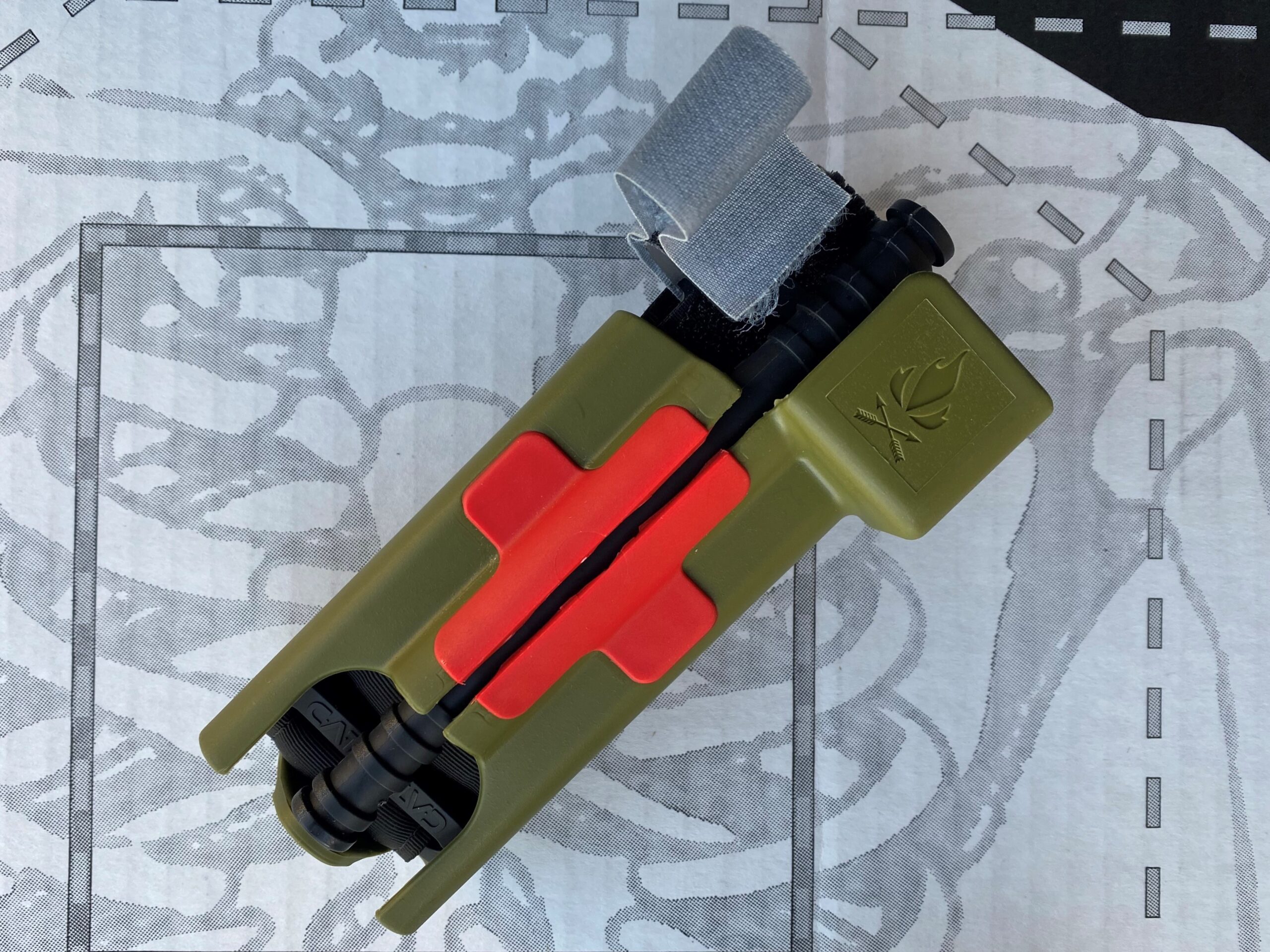May is National STOP THE BLEED® Month. Hemorrhage secondary to traumatic injury is the leading cause of death of Americans from one to 46 years of age. Up to half of the deaths resulting from hemorrhage occur before reaching definitive care.1 Someone who is severely bleeding can bleed to death in as little as five minutes.2 It is the most preventable cause of death in compressible injuries. The only thing more tragic than a life lost is a life lost that could have been saved.
According to published research, EMS units average 7 minutes from the time of a 911 call to arrival on scene. In rural areas, the median time for EMS personnel to arrive is more than 14 minutes, and almost 10% of the cases have to wait for nearly 30 minutes.3 You do the math.
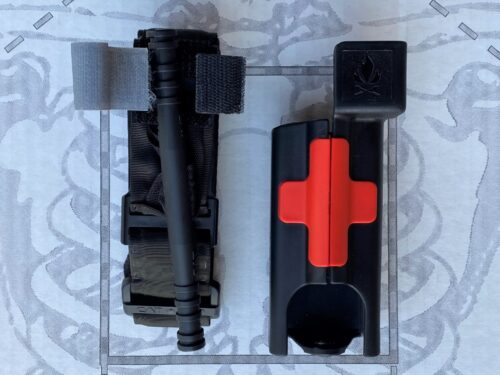
Carrying a Tourniquet
Tourniquets have emerged as the standard of care due to their ease of use, rapid application, and complete stoppage of blood loss. Current protocol considers the tourniquet an initial lifesaving intervention to control massive hemorrhage from an extremity. If you only carry one medical device, it should be a tourniquet (along with nitrile gloves for your protection from blood-borne pathogens). Carrying a tourniquet and knowing how to properly use it can potentially save a life, possibly your own. You are statistically far more likely to encounter a situation where you need to use your tourniquet than your gun. You are your own first responder.
However, not all tourniquets are created equal. Some may be ineffective, unsafe, or even harmful. That’s why it’s important to choose a tourniquet that meets the standards of the Committee on Tactical Combat Casualty Care (CoTCCC). The CoTCCC is a group of experts who review and recommend best practices for treating combat-related injuries. They have tested and recommended tourniquets that are proven to be reliable, durable, and easy to use. By choosing a CoTCCC-recommended tourniquet, you can ensure that you have a high-quality device that can save lives in an emergency.
How you carry a tourniquet is important. You must be able to access it quickly when you need it. Seconds count. While carrying a tourniquet in a med kit or in a bag or pack is easy, carrying a tourniquet on your person close at hand requires some thought. Dropping a tourniquet in your pocket limits access and makes it difficult for others to locate. Rubber banding it to your gear doesn’t protect the tourniquet and is prone to snagging, failure and loss. A good tourniquet holder prevents these issues and keeps your tourniquet accessible and ready should you need it. But, as is the case with tourniquets, all tourniquet holders are are not created equal.
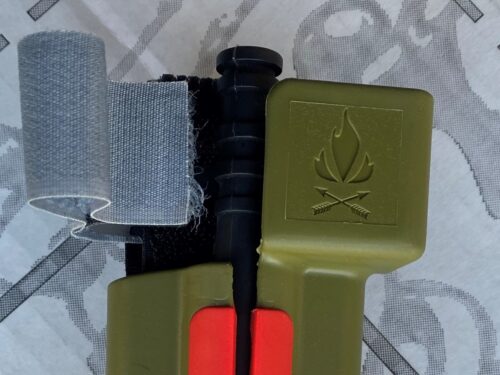
Fieldcraft Survival Tourniquet Holder
The Fieldcraft Survival™ Tourniquet Holder was designed by Fieldcraft Survival founder and CEO Mike Glover to provide secure protected carry and rapid access for the North American Rescue Combat Application Tourniquet® (C-A-T®). It will also accommodate TacMed Solutions™ SOF® Tourniquet. Both are CoTCCC-recommended tourniquets.
Mike spent 18 years in the U.S. Army followed by work as a government contractor. He served as a Sergeant Major in Special Forces and deployed multiple times to combat theaters. He’s an expert in counterterrorism, security, and crisis management operations. He has a bachelor’s degree in Homeland Security. It was Mike’s passion for survival training that led him to found Fieldcraft Survival.
Mike developed the Fieldcraft Survival Tourniquet Holder to provide increased accessibility to the tourniquet and reduce failures in the field. Mike states that it was designed by creating a solution to a problem identified during a stress shoot conducted at a course he was teaching to law enforcement. Five of the 15 officers in the team he was training had a holder that became detached from their belt during the shoot. The holder didn’t have adequate retention and strength with regard to how it was retained on the belt. It snapped off when their upper body stressed it.
There’s no room for a single point of failure when a piece of equipment is lifesaving. The Fieldcraft Survival team started identifying what the issues were. After a year of R&D, they came up with the holder that we now have. In the design process, they sourced subject matter experts including special operations and law enforcement, as well as tactical medical experts.
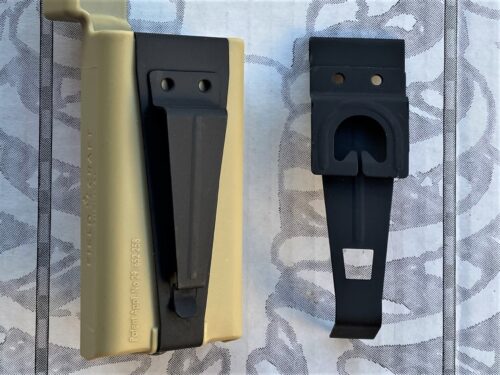
Unique Design
The Fieldcraft Survival Tourniquet Holder is made of tough, injection-molded polycarbonate to stand up to the rigors of LE/MIL usage. The holder is designed for belt or PALS mounting. It measures a compact 5.9”H x 2.5”L x 1.7”D. The patented design has been very well thought out, with some unique features that distinguish it from other tourniquet holders on the market.
The Fieldcraft Survival Tourniquet Holder features a proprietary dual-access design with a tension-grasp feature that keeps the tourniquet securely retained and allows rapid deployment from either the top or front using only gross motor skills. There are no flaps, straps or buckles on the holder to deal with and slow deployment. It has been engineered to allow easy release of the C-A-T single routing buckle when clearing the holder. The holder is self-draining.
The Fieldcraft Survival Tourniquet Holder has a windlass clip protector shroud designed to shield the C-A-T Velcro® windlass clip and help protect it from degradation due to accumulation of lint, dirt and everyday debris. The shroud also prevents the hook Velcro on the C-A-T windlass clip from abrading your apparel. There aren’t any sharp edges on the holder that can cut or fray the tourniquet.
The Fieldcraft Survival Tourniquet Holder has been engineered with a split in the front to allow the tourniquet to be removed forward out the front of the holder in the event that the top is blocked. When simulating an injury in training, you’re often in a comfortable position. But if you’re traumatically injured, you might be in a fetal position compressing your upper body over the only way to pull the tourniquet out if the top is the only means of egress. Mike recommends egress of the tourniquet from the front of the holder only in extremis. This is to avoid unduly stressing the holder, although the polymer is resilient.
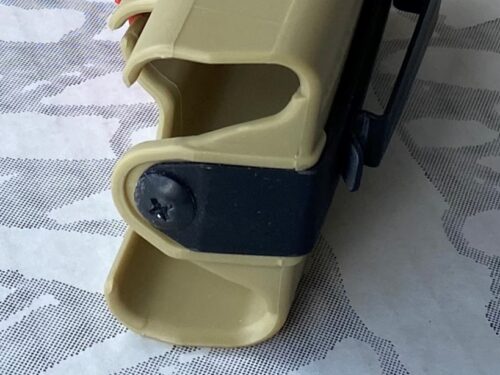
Belt & PALS Clips
The Fieldcraft Survival Tourniquet Holder comes with interchangeable belt and PALS clips. The belt clip fits belts up to 2.25” wide. It works for both inside and outside the waistband carry. The belt clip was designed to mount the holder on standard LE duty belts. The holder will shift around when mounted outside the waistband on narrower belts. It’s a nonissue with inside the waistband carry, which is how I EDC it. Women often opt to clip the holder inside their purse.
The PALS clip attaches to MOLLE-compatible gear. Let’s clear up some common confusion. Although the two terms are often used interchangeably, they are separate components of a system. MOLLE is an acronym for Modular Lightweight Load-carrying Equipment. PALS stands for Pouch Attachment Ladder System, a standard developed for the U.S. military but now found worldwide. It’s the horizontal grid of webbing to which pouches and equipment are attached. Many civilian bags and packs now have PALS webbing due to of its utility.
The clips form the backbone of the Fieldcraft Survival Tourniquet Holder. They’re made of tempered spring steel for superior strength and ductility. They not only provide secure attachment but also allow the holder to be quickly unclipped and handed off to others on-scene should the need arise.
The Fieldcraft Survival Tourniquet Holder has a single screw on the bottom for easy assembly when changing between the belt and PALS clips. The clip is held in place by the screw and a lip that fits over the back edge of the holder. The captured clip retains the holder as part of the overall system.
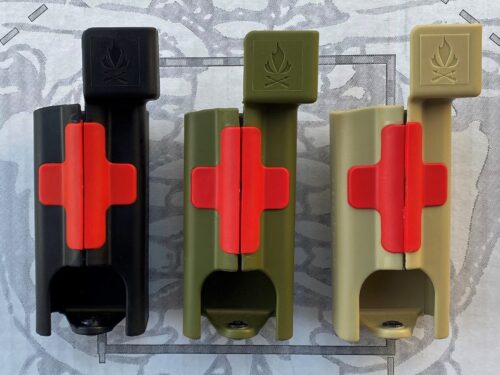
Closing Thoughts
A Fieldcraft Survival Tourniquet Holder has been part of my EDC for the past two years. It’s an innovative, well-executed product that does its job exceptionally well. It’s an outstanding tourniquet holder.
I have opted to carry the C-A-T tourniquet as I have found it easier to quickly self-apply. Also, more people have been trained in its use. The C-A-T has been the Official Tourniquet of the US Army since 2005 and is the most widely issued tourniquet in the world. The windlass clip protector shroud that shields the C-A-T Velcro windlass clip, the dual egress and the rugged design were the reasons I chose the Fieldcraft Survival Tourniquet Holder for EDC.
The Fieldcraft Survival Tourniquet Holder ii available for t $49.99 USD on the Fieldcraft Survival website. It’s available in red-on-black; red-on-olive; and red-on-sand colorways.
Get Trained
Carrying a tourniquet is only part of the equation. Training is essential. The American College of Surgeons’ STOP THE BLEED® program is an outstanding training resource. The STOP THE BLEED program is a national initiative that aims to train people in basic bleeding control techniques and equip public venues with bleeding control kits. The program is based on the lifesaving lessons learned from military medicine and research. By taking a STOP THE BLEED course, you can learn how to use your hands, dressings, and tourniquets to stop life-threatening bleeding in an emergency situation. Since its inception, the STOP THE BLEED campaign has trained over 2.6 million people worldwide on how to control serious bleeding.
Sources
Fieldcraft Survival
FieldcraftSurvival.com
STOP THE BLEED
STOPTHEBLEED.org
Endnotes
1. Donley ER, Munakomi S, Loyd JW. Hemorrhage Control. 2022 Nov 16. In: StatPearls [Internet]. Treasure Island (FL): StatPearls Publishing; 2022 Jan–. PMID: 30571014.
2. American College of Surgeons Committee on Trauma. “Learn More.” STOP THE BLEED®, 12 April 2023, https://www.stopthebleed.org/learn-more/.
3. Mell HK, Mumma SN, Hiestand B, Carr BG, Holland T, Stopyra J. Emergency Medical Services Response Times in Rural, Suburban, and Urban Areas. JAMA Surg. 2017;152(10):983–984. doi:10.1001/jamasurg.2017.2230.
Material Disclosure
I received this product as a courtesy from the manufacturer so I could test it and give my honest feedback. I am not bound by any written, verbal or implied contract to give this product a good review. All opinions are my own and are based off my personal experience with the product.
*The views and opinions expressed on this website are solely those of the original authors and contributors. These views and opinions do not necessarily represent those of Spotter Up Magazine, the administrative staff, and/or any/all contributors to this site.
